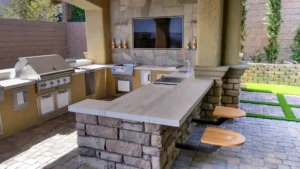Outdoor Kitchen Contractor Near Me is a high-end project that requires a contractor with professional experience and knowledge. Choosing the right one is important for getting the finished product you want and deserve.
One way to gauge a contractor’s reputation is whether they have a backlog of projects in progress. A good contractor will always have a project in the works and update you about progress.

A quality outdoor kitchen requires durable building materials that withstand high temperatures, rain, and sun exposure. Some options include wood, concrete, brick, and steel. A contractor may construct the entire kitchen from these materials or use a prefabricated frame with cabinets. In either case, the materials used will make a difference in the long-term durability of your kitchen.
If your outdoor kitchen will be built with a wooden frame, it will require a backer board to protect the wood from water and heat. Typically, the backer board is constructed with cement. The frame can then be faced with decorative concrete panels, stucco, stone, tile, or brick veneers. Wood-frame construction allows for a wide range of customization to match your style and preferences.
Whether planning a wood or concrete block structure, you must consult your local permitting department about zoning and building codes. Most municipalities require a permit to install any structure that will house an electric appliance, and some will also require permits to run gas, water, and drain lines. You will also need to check your home title for easements that might restrict where you can build.
Once the base is constructed, you must hire an electrician to run GFCI-protected outlets and install any permanent lighting. If your project includes a grill, it will be necessary to have a plumbing contractor complete the gas, water, and drain lines.
At Watson Supply, we offer a selection of fire pits, grills, and accessories from leading brands like Firegear Outdoors, Breeo, Round Grove, Warming Trends, and Unilock. We also provide the raw materials needed to construct a custom outdoor kitchen.
There are several different frame options when it comes to an outdoor kitchen. Some homeowners use a wood frame, while others choose metal or concrete. The choice of frame material can make a big difference in the final look and cost of the project.
A wood frame can be less expensive and work better for a DIY project. It is also easy to install the necessary backer board and add decorative concrete panels, stucco, or stone veneers for a customized look. However, the wood must be treated or sealed with a water-resistant coating, and repeated wetting and drying cycles can cause the wooden structure to crack and eventually need replacement.
Using the right type of wood for the frame is also important. It should be pressure-treated pine, if possible, and not pallet wood. Pallet wood is often sprayed with chemicals that aren’t safe to eat and is not resistant to the variations in weather that an outdoor kitchen will experience.
Another disadvantage of a wood frame is that it can be difficult to run electrical wires through it. This may be an issue if you plan to install a grill, pizza oven, or smoker in the frame. It will also be a concern if you plan to use an outdoor lighting system in the kitchen area.
The good news is that a qualified professional can handle all of these challenges for you. A contractor specializing in outdoor living projects will be familiar with the construction methods and materials used to create a beautiful, functional, and durable frame for your outdoor kitchen. The best way to find a great contractor is by checking reviews online and asking for references from past clients.
Concrete blocks, also known as concrete masonry units or CMU, are a durable and versatile building material used in many structures. They are available in a wide range of shapes and sizes and can be customized to suit specific projects.
There are two primary concrete block categories: hollow and solid. Hollow blocks, sometimes called “knock-out blocks” because of the holes they have in them, are lighter and allow for more flexibility when installing wiring, piping, or other materials in your outdoor kitchen design. Solid blocks are typically more durable but less versatile in shape and size than hollow concrete blocks.
A concrete block has a variety of finishes that can be used to create a custom look on a building facade or interior wall. For example, an antique finish exposes the aggregate to provide a weathered look. Other finishes, such as ground-face and shot blast finish, leave the aggregate exposed but smooth, giving the block a polished look suitable for interior and exterior walls.
The first step to building a cinder block outdoor kitchen is clearing the site for the structure. Clearing the area removes debris interfering with the structure’s strength or longevity. Then, the soil must be leveled so that appliances like grills and sinks are installed at an even height.
Before cement is poured, the cinder block construction must be waterproofed. This can be done using an epoxy coating designed to withstand moisture. Choosing a high-quality coating that will not chip or peel is important, especially in high-traffic areas. The waterproofing must also meet any local building codes.
Whether you want to grill and entertain or enjoy a quiet evening in your backyard, an outdoor kitchen can add value to your home. Adding an outdoor kitchen to your yard can be an investment, so hiring a contractor with experience and knowledge of the different materials available and the building codes required for local areas is important. A mason with the proper training and equipment is necessary, but other contractors may be needed to assist with plumbing, electrical, gas line installation, granite countertop fabrication, and more.
Choosing the right brick materials for your outdoor kitchen will determine how long it can be expected to last. Many people use brick for their outdoor kitchen because it is durable, easy to maintain, and has a timeless appeal. However, it is important to consider the size of your patio and other factors, such as weather conditions and the amount of sunlight your area receives, before deciding on the type of brick for your project.
The construction process for a brick outdoor kitchen begins with a foundation and utility lines being run. Once the site has been prepped, a concrete footing should be poured to support the weight of your new kitchen. Make sure the footing is at least an inch below ground level and should be twice as wide as your BBQ island.
Once the foundation is laid, a dry course of bricks should be constructed. This first course will form the outline of your kitchen and must be carefully measured and marked for accuracy. As you build the remaining courses, apply mortar between each brick and on the head of each brick to ensure a sturdy and strong structure. When all the classes have been built, double-check your kitchen layout for accuracy and ensure the base is plumb and level.
Choosing the material for an outdoor kitchen frame is one of the first decisions. This will greatly impact construction speed, cost, and longevity. Wood, steel, and concrete are all common choices. Each has its own set of benefits and drawbacks.
For example, a steel frame is more expensive than wood but can last up to twice as long. It also provides more structural support. This is especially important if the frame will hold heavy appliances and countertops. The frame must withstand the weight and force of these items without flexing or cracking.
A steel frame is typically welded together. This makes it easier to build an outdoor kitchen and provides more structural integrity. Welded frames are also cheaper than wooden or concrete frames because they do not need to be treated with chemicals. However, they can be difficult to work with and require specialized tools.
Another option is to use a concrete slab as the foundation for an outdoor kitchen. It is cost-effective and visually appealing, but it will require regular maintenance to prevent cracking or sinking into the ground. Concrete also needs to be resealed annually.
A wood-frame kitchen can be built on a concrete slab. It is more cost-effective than a brick structure and can be topped with an outdoor-rated cladding material, such as stucco, tile, or stone veneer. This type of construction allows for greater customization and can be constructed in various shapes. It is also resistant to insects and can withstand the elements. However, it is less durable than a concrete block or steel frame construction.
